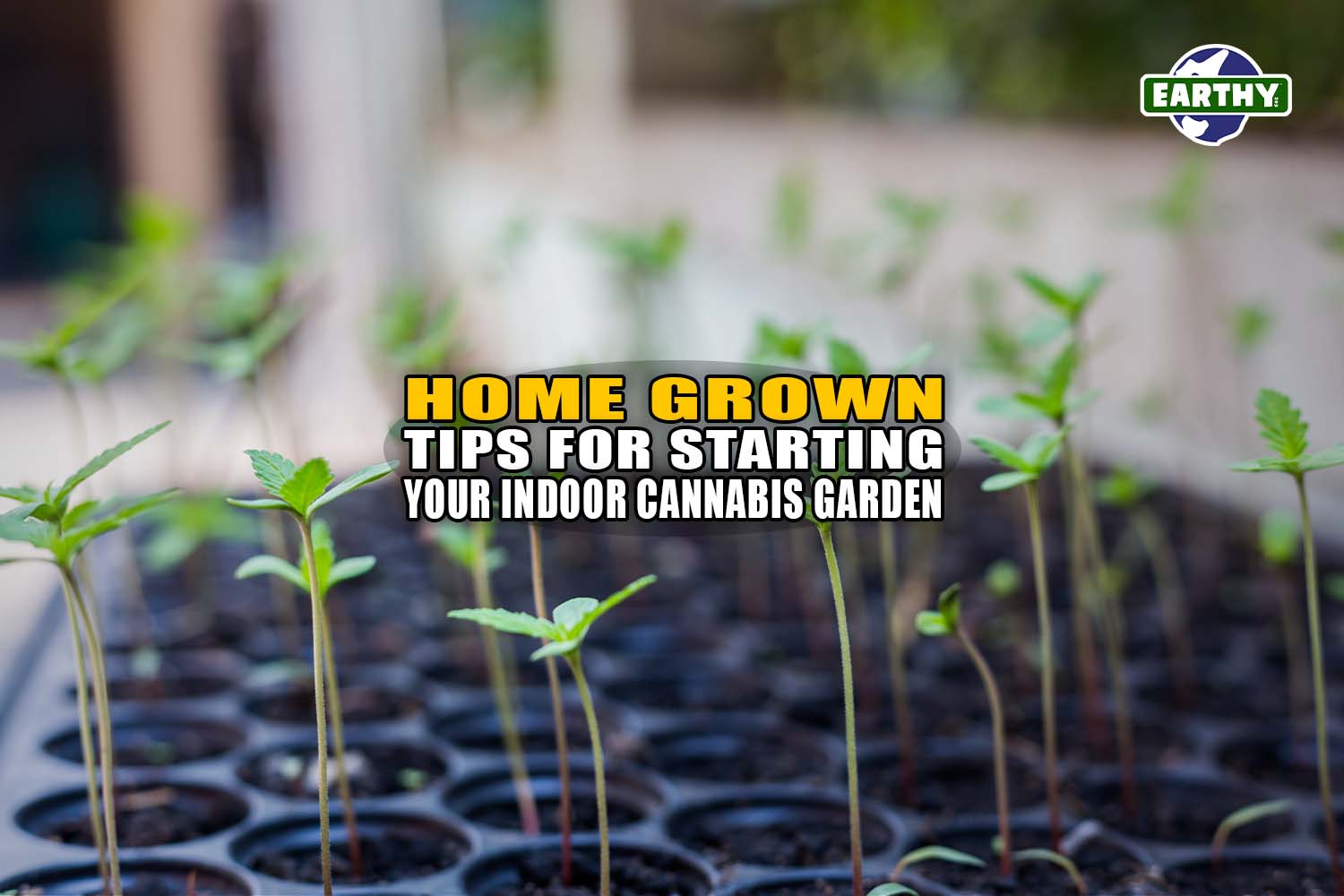The popularity of indoor cannabis cultivation has soared in recent years, allowing enthusiasts to enjoy a personalized growing experience right at home. For many, growing marijuana and hemp indoors offers numerous benefits, such as control over the growing environment and the ability to produce high-quality buds year-round [1]. This article aims to provide essential tips and guidance for beginners looking to start their own indoor cannabis garden.
Legal considerations
Before you start your indoor cannabis garden, it’s crucial to understand the legal status of cannabis cultivation in your area. Notably, laws and regulations vary widely, so growers must research their local laws to ensure compliance. Also, some regions may require permits or have restrictions on the number of cannabis plants you can grow [2]. Thus, adhering to these regulations will help avoid any legal issues and allow growers to focus on cultivating healthy plants.
Can Legalization Lower the Carbon Footprint of Cannabis?
Setting up your grow space
It’s important to choose the right location within your home for your grow room. For example, you’ll need a dedicated space that provides enough room for your cannabis plants to grow. A spare room, closet, or even a grow tent can serve as an ideal grow space. Also, ensure the area has good air circulation, proper ventilation, and access to electricity for your grow lights and other equipment.
Additioanlly, ventilation is key in an indoor grow room to maintain optimal temperature and humidity levels. Thus, strategically position intake and exhaust fans to bring in fresh air and expel stagnant air. As a result, the subsequent air circulation will promote healthy plant growth and prevent mold spores from settling [3].
Essential equipment
Grow lights
One of the most critical pieces of equipment for indoor cannabis cultivation is the grow light. However, there are several types of grow lights to choose from, including LED grow lights, HPS bulbs, and CFLs. LED grow lights are popular among cannabis growers for their energy efficiency and spectrum control, making them suitable for all stages of plant growth [3].
Grow tents and enclosures
A grow tent or grow box provides a controlled environment for your cannabis plants. These enclosures come in various sizes to fit different spaces and help to contain light, odor, and humidity [3].
Ventilation systems
Proper ventilation is essential for maintaining the right temperature and humidity levels in your grow room. More specifically, intake and exhaust fans, coupled with carbon filters, ensure air circulation and odor control. An exhaust fan helps to remove heat and stale air, while an intake fan brings in fresh air rich in carbon dioxide, which is necessary for plant growth [4].
Monitoring tools
To grow healthy cannabis plants, you need to monitor the growing environment closely. Typically, thermometers, hygrometers, and pH meters work best to track temperature, humidity, and soil pH levels. As a result, you can ensure optimal conditions for your plants [5].
Selecting your cannabis strain
Importantly, you must choose your cannabis cannabis strain wisely for successful indoor growing. Cannabis strains vary in their growth characteristics, flowering times, and effects. For example, indica strains are typically shorter and bushier, making them suitable for limited grow spaces, while sativa strains are taller and may require more vertical room. In contrast, hybrid strains offer a balance of characteristics. Purchasing feminized seeds ensures that you grow only female plants, which produce the potent buds desired by most growers [6].
Planting and germination
Germinating cannabis seeds marks the first step in starting your indoor garden. However, you can choose from various methods to germinate seeds, such as the paper towel method or planting directly in the soil. Once germinated, you can transplant seedlings into a growing medium, such as soil or a hydroponic system. Notably, hydroponic systems use nutrient-rich water instead of soil, promoting faster root development and growth [7].
Nutrients and watering
Cannabis plants require specific nutrients for healthy growth. For example, during the vegetative stage, they need higher levels of nitrogen. In contrast, the flowering stage demands more phosphorus and potassium. Many growers prefer organic nutrients for their natural benefits. Also, proper watering practices help growers avoid overwatering or underwatering, which can harm plant health [4].
Light and temperature management
Proper light cycles promote optimal cannabis growth. For example, during the vegetative phase, plants need 18-24 hours of light per day. In contrast, the flowering phase requires 12 hours of light and 12 hours of darkness. Additionally, the room’s temperature and humidity levels need to be carefully controlled for optimal growth conditions. Cannabis plants thrive in temperatures between 70-85°F during the vegetative stage and slightly cooler during the flowering stage. Humidity levels should be kept around 40-60% during the vegetative growth and reduced to 40-50% during flowering to prevent mold and mildew [8].
Pruning and training techniques
Pruning and training techniques help maximize light exposure and promote healthy growth. For instance, topping and fimming encourage bushier plants by removing the main growth tip. Additionally, Low Stress Training (LST) can help plants thrive. Encouraging an even canopy, LST involves bending and tying down branches. Alternatively, the Screen of Green (ScrOG) method uses a screen to spread out branches, increasing light penetration and bud production [9].
Pest and disease control
Indoor growing can still present pest and disease challenges. Common pests include spider mites, aphids, and fungus gnats. However, if you regularly inspect your plants and maintain a clean grow room, you can help prevent infestations. Also, organic pesticides and beneficial insects can foster effective pest control. Keep in mind that ensuring proper air circulation and humidity control reduces the risk of mold and mildew [10].
How to Deal with Common Plant Pathogens: Mold, Spider Mites, and Mildew
Harvesting and curing
To create a quality cannabis bud, you need to harvest at the right time. Look for milky white or amber trichomes as indicators of readiness. After harvesting, trim the buds and begin the drying process by hanging them in a dark, well-ventilated area. Typically, curing involves storing the dried buds in airtight containers and burping them regularly to release moisture and enhance flavor and potency [11].
10 Great Wholesale Hemp Shopping Tips
Troubleshooting common issues
Even experienced growers encounter challenges. For example, nutrient deficiencies can manifest as yellowing leaves or stunted growth. Overwatering and underwatering are common problems that can be avoided with proper watering practices. However, monitoring and adjusting temperature and humidity levels prevent environmental stressors from diminishing plant health [3].
3 Reasons Your Small Business Should Consider CBD Products
Indoor vs outdoor growing
Growing indoors and outdoors each has its own set of advantages and challenges, appealing to both first-time growers and experienced cultivators. For example, in grow rooms, you have complete control over the environment, allowing for precise adjustments to temperature, humidity, and light cycles. This controlled environment particularly benefits the vegetative and flowering stages of the cannabis plant, ensuring consistent growth and high-quality yields. Also, indoor growing provides the flexibility to cultivate cannabis plants year-round, independent of external weather conditions. For those starting with just a few plants, using fabric pots and a suitable grow medium, such as good soil or hydroponic systems, can help optimize root development and overall plant health [12].
On the other hand, outdoor growing leverages natural sunlight, which can promote vigorous growth in hemp and marijuana plants. Indeed, many experienced growers appreciate the robust and expansive growth that outdoor conditions can provide, often resulting in larger plants and higher yields. However, outdoor cultivation is subject to environmental variables such as weather, pests, and fluctuating temperatures, which can pose challenges throughout the growth stages. Thus, those growing weed outdoors should select a good location with good soil and adequate sunlight. D
espite the challenges, growing cannabis outdoors can be less resource-intensive and more sustainable. In contrast, those who choose to grow cannabis indoors must invest in equipment like grow lights, ventilation systems, and climate control tools to mimic optimal outdoor conditions. Ultimately, whether you decide to grow indoors or outdoors depends on your resources, experience level, and personal preferences, with each method offering unique benefits and challenges [12].
From Seed to Smoke: A Beginner’s Guide to Growing Your Own Cannabis
Premium cannabis products from Earthy Now
Waiting for your harvest? For cannabis enthusiasts seeking reliable, organic cannabis flower and hemp-derived products, Earthy Now has something for everyone. These products are the industry’s cleanest and strongest, with only trace amounts of Delta-9 THC.
Explore these popular products from Earthy Now:
- CBD Flower
- Gummies
- Lozenges
- Tablets (THC Free!)
- Soothing Relief Lotion
- Soothing Relief Salve
- CBD Pet Tinctures (no THC!)
- Oils
- Pre-Rolls
- Smokes
- Terpenes
Where Does CBN (Cannabinol) Come From?
Key takeaway: indoor cannabis cultivation
Starting an indoor cannabis garden can be rewarding for both beginner growers and experienced cultivators. By following these tips and maintaining a controlled environment, you can grow thriving cannabis plants and enjoy the fruits of your labor. Remember, each growing experience offers new learning opportunities, so stay curious and keep experimenting.
Visit Earthy Now and discover premium, organically-grown cannabis flower and other products!
Medical Disclaimer / Legal Disclaimer – Information is provided for educational purposes. It does not and is not intended to constitute legal advice or medical advice. We attempt to be accurate and up-to-date, but the legality of cannabinoids and the science of cannabis are evolving. The author is neither a legal professional nor a medical expert. Before buying or using any products, you should check with your local authorities and medical providers.
References
- Home-Grown Cannabis: How COVID-19 Fuelled a Boom
- Which States Allow You to Grow Your Own Recreational or Medical Cannabis?
- How To Grow Weed Indoors
- Air Circulation & Exhaust Tutorial
- The Importance of Measuring Equipment for Growing Cannabis
- Top 6 Weed Strains to Grow Indoors
- Hydroponic vs Soil Cannabis Growing
- Ideal Grow Room HVAC Temperature and Humidity for Cannabis
- Master Advanced Techniques for Pruning and Training Cannabis Plants
- Cannabis Pest Control: Prevention and Management Strategies
- Beginner’s Guide to Harvest, Drying, and Curing
- Grow Room Odor Control





